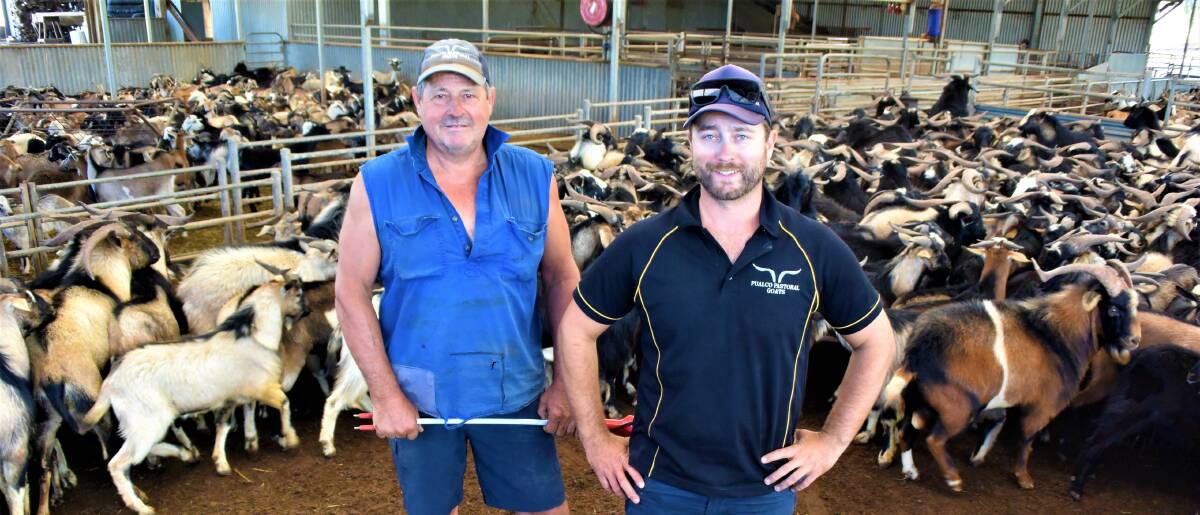
AFTER being hidden amongst all of the hype within the red meat sector recently, rangelands goats have become the dark horse at the beginning of 2022, after bolting to the front and breaking another slaughter record last week.
Subscribe now for unlimited access to all our agricultural news
across the nation
or signup to continue reading
National goat slaughters reached 36,259 head, recording its highest slaughter rates in almost five years.
Processor throughput has now consistently reached more than 35,000 goats a week in March and as interstate goat producers and SA rangeland goat harvesters begin rebuilding and regaining their feet on the ground after significant drought across the country, slaughter numbers are exploding.
A Meat and Livestock Australia goat market snapshot report zeroed in on the first quarter of this year and revealed that nationally, throughput had jumped by 25 per cent compared to 2021 levels, while its counterparts, lamb and cattle, were below 2020 and 2021 levels.
Thomas Elder Markets analysist Matt Dalgleish said since January, national throughput had doubled.
"We have been keeping an eye on goats - a rising population of Asian and Indian subcontinent ethnicity means demand is there and the Australian goat meat sector can meet it.
"The name change from 'feral' goat to rangeland goat has also increased its popularity across Australia in particular - there are many layered reasons as to how and why the numbers are being absorbed."
Mr Dalgleish was quite surprised at its "sudden" high position on the meat market but said it had been a growing market for some time.
"There has been growth in two of the country's largest markets, Vic and Qld, that supply 80pc of Australia's goat meat. Those two states are turning off more goats than ever.
"In SA - mustering is in full swing and we are seeing some very high numbers out of there too."
With demand fueled by the export market, from September to December last year, Australia exported 2100 tones of shipweight goat meat a month, jumping from 1400t in the earlier part of 2021.
Throughout 2020, that figure was below 1000t and Mr Dalgleish expected increased volumes as 2022 continues.
The interest in Australian goat meat remains driven by United States imports, with an average of 1500t from the total 2100t heading to the USA each month.
The global export picture for goat meat is similar to the situation for sheep meat, in that there really is only two major suppliers to the world - Australia and New Zealand.
Analysis of the top goat meat importing nations highlighted that the USA is the number one importer of goat meat and Australia almost exclusively supplies goat meat to the USA.
Last year, analysists predicted that prices for goat meat would be reflective of increased demand, with the annual average over-the-hooks price for 2022 expected to be 818 cents a kilogram carcase weight with a potential range between 736c/kg to 900c/kg.
This week's OTH price was at 49.80/kg and as goat supply escalates out of the Flinders Ranges and Broken Hill, TFI national livestock manager Paul Leonard revealed that the Stall facility in Victoria will begin processing goat to handle the recent surge in supply.
"We are processing goats six days a week at Lobethal and to help take some of the volume, in the short term, Stall will begin processing too.
But as goat supply is expected to continue at record levels, the recent acquisition of a processing facility at Bourke, NSW, means TFI will have a new, "premier" goat processing site.
"In the medium to long-term future, we utilise the Bourke abattoir and we hope to have that commissioned and ready to go by mid-year," Mr Leonard said.
"It will become the premier, preferred site for goats."
GOAT THROUGHPUT HITS A HIGHPOINT
RANGELAND goat wranglers have been inundated with numbers in the past few months, delivering some of the highest numbers to depots in more than six years.
Just at the weekend, about 300 goats arrived at Pualco Pastoral Goat Depot at St Kitts and about 850 head were trucked to major processor, Thomas Foods International, on Wednesday.
Pualco owner/operator Stephen Obst has been offloading in excess of 5000 goats each week for just less than a month, compared to about 3000 prior to that.
Mr Obst cannot pinpoint the main driver causing increased rangeland goat populations across SA's pastoral districts but he certainly did not realise that such high numbers were floating around in the bush.
"The north has had good rain and it has certainly strengthened the populations with good feed and breeding conditions," he said.
"Whether or not the pastoral areas have had more time to muster as well - it has come out of the blue because prior to November, numbers were a bit slow."
An increase in helicopter ground crews and opportunistic mustering as a result of the higher numbers has meant Mr Obst's depot, which can also house 4000 goats undercover, has been holding onto goats for about 10 days longer than usual.
"It has been a combination of processing delays and increased numbers," he said.
Despite being a bit baffled by the burst of activity in the sector, it has been a long-time coming says Mr Obst and demand for the product has meant increased supply is being absorbed.
-VANESSA BINKS
RELATED: Goat production up
- Start the day with all the big news in agriculture. Sign up here to receive our daily Stock Journal newsletter.


